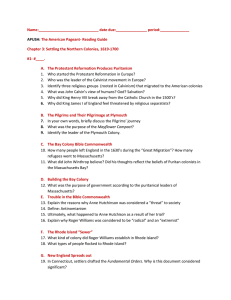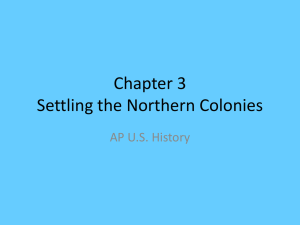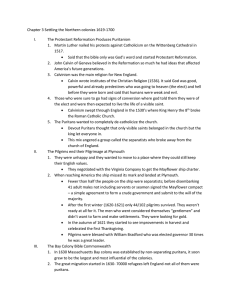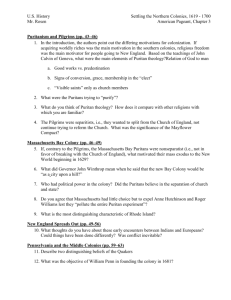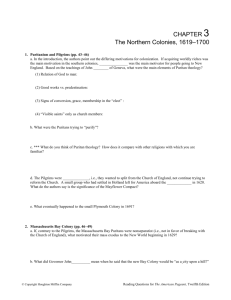Settling The Northern Colonies
advertisement
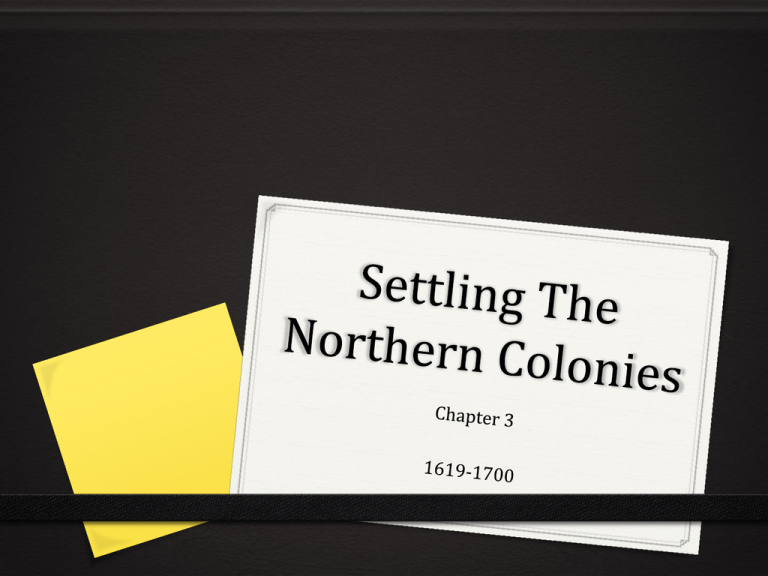
The Protestant Reformation Produces Puritanism 0 German friar Martin Luther denounced the Catholic Church when he nailed his 95 Theses to the door of Wittenberg’s cathedral in 1517. 0 He declared that the Bible alone was the source of God’s word. He started the “Protestant Reformation.” The Protestant Reformation Produces Puritanism 0 John Calvin of Geneva elaborated Martin Luther’s ideas. 0 He spelled out his basic doctrine in Latin in 1536, entitled Institutes of the Christian Religion. 0 These ideas formed Calvinism. The Protestant Reformation Produces Puritanism 0 King Henry VIII broke his ties with the Roman Catholic Church in the 1530s, he formed the Church of England The Protestant Reformation Produces Puritanism 0 There were a few people who wanted to see the process of taking Catholicism out of England occur more quickly. These people were called Puritans. 0 A tiny group of Puritans, called Separatists, broke away from the Church of England. The Pilgrims End Their Pilgrimage at Plymouth 0 Separatists leave Holland. 0 Mayflower missed Virginia and landed near Plymouth Rock in 1620. 0 Captain Myles Standish-Standish was hired by the Pilgrims to be their military captain, to establish and coordinate the Colony's defense against both foreign (French, Spanish, Dutch) and domestic (Native American) threats. The Pilgrims 0 Pilgrim leaders signed the Mayflower Compact. 0 It was a simple agreement to form a government 0 It was signed by 41 adult males. It was the first attempt at a government in America. 0 In the Pilgrims’ first winter of 1620-1621, only 44 of the 102 survived 0 Many non-separatist went back to England. Pilgrims continued 0 1621 - first Thanksgiving Day in New England. Celebration for the good autumn harvest. 0 Economy of Plymouth was based on fur trading, fishing and lumber. 0 William Bradford- elected 30 times as governor of the Pilgrims in the annual elections 0 He was a self-taught scholar who read Hebrew, Greek, Latin, French, and Dutch; Pilgrim leader. The Bay Colony Bible Commonwealth 0 1629 Charles I dismissed Parliament 0 An energetic group of non-Separatist Puritans, fearing for their faith and for England’s future, secured a royal charter to form the Massachusetts Bay Company. 0 During the Great Migration of the 1630s, about 70,000 refugees left England for America The Bay Colony Bible Commonwealth 0 John Winthrop- the Bay Colony’s first governor served for 19 years. 0 Winthrop wanted to create a “City Upon a Hill” 0 Voting and decision making were left to members of the church. The Rhode Island “Sewer” 0 Roger Williamspopular Salem minister who also challenged the Church; an extreme Separatist; was banished from the Massachusetts Bay Colony. The Rhode Island “Sewer” 0 Anne Hutchinson- an intelligent woman who challenged the Puritan orthodoxy; was banished from the Massachusetts Bay Colony because of her challenges to the Church. New England Spreads Out 0 Hartford and Connecticut were founded in 1635. Boston Puritans poured into the Hartford area led by Reverend Thomas Hooker. 0 In 1639, settlers of the Connecticut River colony drafted the Fundamental Orders. It was a basic constitution. 0 New Haven, CT was established in 1638. 0 Part of Maine was purchased by Massachusetts Bay in 1677 from the Sir Ferdinando Gorges heirs. Puritans versus Indians 0 The Wampanoag chieftain, Massasoit, signed a treaty with the Plymouth Pilgrims in 1621. 0 In 1637, hostilities exploded between the English settlers and the powerful Pequot tribe. 0 The English annihilated the Pequot tribe 0 In 1675, Massasoit’s son, Metacom, also called King Philip, launched a series of attacks and raids against the colonists towns. The war ended in 1676. Seeds of Colonial Unity and Independence 0 1643 - 4 colonies banded together to form the New England Confederation for defense 0 only Puritan colonies 0 Each colony had 2 votes, regardless of size. Edmund Andros 0 In 1686, the Dominion of New England was created by royal authority 0 In 1688, it was expanded to New York and East and West Jersey 0 The leader of the Dominion of New England was Sir Edmund Andros 0 His headquarters were in Puritanical Boston William and Mary 0 Andros stopped the town meetings; laid heavy restrictions on the courts, the press, and schools; and revoked all land titles. 0 In 1688-1689, England engineered the Glorious (or Bloodless) Revolution. They dethroned Catholic James II and enthroned the Protestant rulers of the Netherlands, the Dutch-born William III and his English wife, Mary, daughter of James II. Old Netherlands at New Netherlands 0 The Dutch won their independence from Spain in the late 16th century 0 The Dutch Republic became a leading colonial power, with by far its greatest activity in the East Indies in the 17th c. The Dutch New Netherland 0 The Dutch East India Company was nearly a state within a state and at one time supported an army of 10,000 men and a fleet of 190 ships, 40 of them menof-war Henry Hudson 0 Hired by the Dutch East India Company to seek riches 0 Sailed into the Delaware Bay and New York Bay in 1609 and then ascended the Hudson River. He filed a Dutch claim to a wooded and watered area The Dutch in the New World 0 1623-1624 - the Dutch West India Company established New Netherland in the Hudson River area. 0 It was made for quick-profit fur trade. The company also purchased Manhattan Island from the Indians for worthless trinkets. The island encompassed 22,000 acres. 0 New Amsterdam, later New York City, was a company town. The Dutch abused the local Quakers terribly. New Amsterdam Ends 0 1664 - the Dutch were forced to surrender to the English when a strong English squadron appeared off the coast of New Amsterdam. 0 New Amsterdam was renamed New York, after the Duke of York. Pennsylvania (again) 0 Quakers began their religious dissent in the mid-1600s in England 0 Religious Society of Friends 0 They refused to support the Church of England with taxes William Penn Pennsylvania 0 The Quakers treated the Indians very well. 0 Many immigrants came to Pennsylvania seeking religious freedom 0 By 1700, Pennsylvania surpassed all but Massachusetts and Virginia as the most populous and wealthy colony 0 In 1664, New Jersey was formed when two noble proprietors received the area from the Duke of York The Middle Colonies 0 New York, New Jersey, Delaware, and Pennsylvania make up the Middle Colonies 0 They were known as the “bread colonies” because of their heavy exports of grain. 0 These colonies were more ethnically mixed than any of the other colonies 0 Religious tolerance was a characteristic of the Middle Colonies
